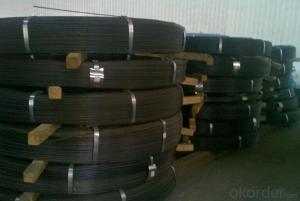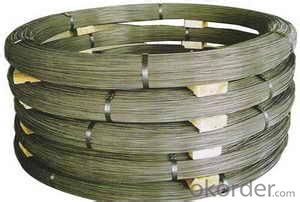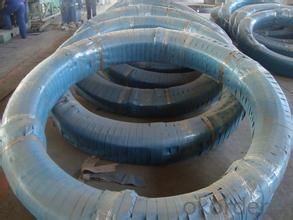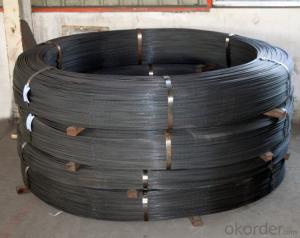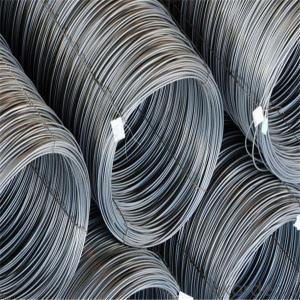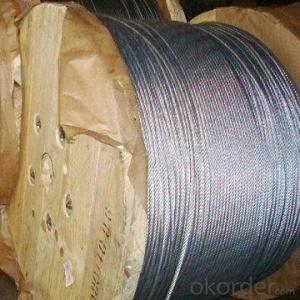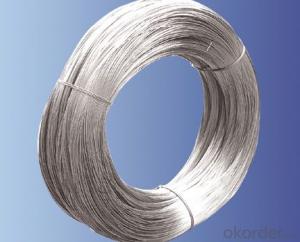Alloy Strand Steel Wire
- Loading Port:
- China Main Port
- Payment Terms:
- TT or LC
- Min Order Qty:
- -
- Supply Capability:
- -
OKorder Service Pledge
OKorder Financial Service
You Might Also Like
Quick Details
| Steel Grade: | SWRH77B, SWRH82B | Standard: | ASTM,BS,GB,JIS | Wire Gauge: | 4.0mm-10.0mm |
| Place of Origin: | Tianjin China (Mainland) | Type: | Drawn Wire,Spiral/Helical Ribs, Round Plain | Application: | Construction |
| Alloy Or Not: | Is Alloy | Special Use: | Free Cutting Steel | Model Number: | 4.0-10.0mm |
| Product Name: | prestressed steel wire 4mm high carbon steel wire | Size: | 4.0-10.0mm | ||
| Strength: | 1570/1670/1770/1860 N/mm2 | Relaxation: | Less than 2% (1000hour) | Elongation: | Not less than 4% |
| MOQ: | 10 Tons | Payment: | TT, LC | Delivery: | 10-15 work days |
| Package: | As your requirements |
Packaging & Delivery
| Packaging Detail:steel strand coil to be packed in damp proof materials strapped with 8 bands on one wooded pallet with an outer layer of plastic used for anti-rainshower 2 or 3 wooden block undermeath each coil. | |
| Delivery Detail:within 2 weeks |
Specifications
high carbon class A steel wire
Constructon:7 steel wire
material:wire 82B
FAQ of Alloy Strand Steel Wire:
①How is the quality of your products?
Our products are manufactured strictly according to national and internaional standard, and we take a test on every pipe before delivered out. Guaranteed: If products’ quality don’t accord to discription as we give or the promise before you place order, we promise 100% refund.
②How about price?
Yes, we are factory and be able to give you lowest price below market one, and we have a policy that “ for saving time and absolutely honest business attitude, we quote as lowest as possible for any customer, and discount can be given according to quantity”,if you like bargain and factory price is not low enough as you think, just don’t waste your time.Please trust the quotation we would give you, it is professional one.
③Why should you chose us?
Chose happens because of quality, then price, We can give you both.Additionally, we can also offer professional products inquiry, products knowledge train(for agents), smooth goods delivery, exellent customer solution proposals.Our service formula: good quality+good price+good service=customer’s trust
SGS test is available, customer inspection before shipping is welcome, third party inspection is no problem.
Any question, pls feel free to contact us !
Alloy Strand Steel Wire Images:
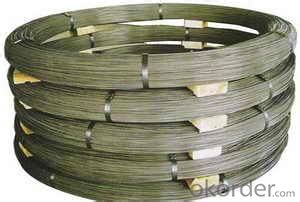
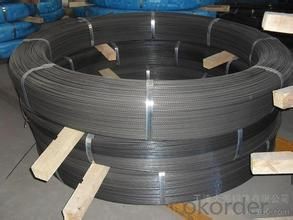
- Q: How is steel wire rod used in the manufacturing of wire forms for automotive exhaust systems?
- The manufacturing of wire forms for automotive exhaust systems heavily relies on steel wire rod. These wire forms are essential for providing structural support and stability to the exhaust system, ensuring its optimal functioning and long lifespan. To begin with, steel wire rod is employed to construct the primary framework of the wire form, which serves as the backbone of the exhaust system. This framework is responsible for securely holding and positioning various components of the exhaust system, including the muffler, catalytic converter, and pipes. The remarkable tensile strength and durability of steel wire rod make it an ideal choice for this purpose, as it can withstand the intense vibrations, heat, and pressure that the exhaust system encounters. Furthermore, steel wire rod is utilized to shape the hangers and brackets that fasten the exhaust system to the vehicle's chassis. These hangers and brackets are crucial for maintaining the correct alignment and stability of the exhaust system, preventing any unnecessary movement or rattling. The flexibility and malleability of steel wire rod enable it to be easily formed into the desired hanger or bracket design, ensuring a precise fit and dependable performance. Moreover, steel wire rod is also employed in the fabrication of wire mesh screens and filters that are installed within the exhaust system. These screens and filters play a vital role in trapping and eliminating contaminants, such as particulate matter and harmful gases, from the exhaust gases before they are released into the environment. The exceptional strength and corrosion resistance of steel wire rod make it an excellent choice for constructing these screens and filters, as they must endure harsh operating conditions and exposure to corrosive elements. In conclusion, steel wire rod plays a critical role in the manufacturing of wire forms for automotive exhaust systems. Its impressive tensile strength, durability, flexibility, and corrosion resistance make it the ideal material for constructing the main framework, hangers, brackets, and screens/filters within the exhaust system. By utilizing steel wire rod, manufacturers can ensure that the wire forms provide the necessary structural support, stability, and reliability required for the proper functioning of automotive exhaust systems.
- Q: What are the different types of steel wire rod surface defect detection methods?
- There are several types of steel wire rod surface defect detection methods, including visual inspection, magnetic particle inspection, ultrasonic inspection, eddy current inspection, and laser scanning. Each method has its advantages and limitations, but they all serve the purpose of identifying and assessing surface defects in steel wire rods to ensure quality and safety.
- Q: What are the different types of steel wire rod heat treatments?
- There are several different types of heat treatments that can be applied to steel wire rods, each with its own purpose and desired outcome. These treatments include: 1. Annealing: This process involves heating the steel wire rods to a specific temperature and then slowly cooling it down to relieve internal stresses and improve its ductility and toughness. 2. Normalizing: Similar to annealing, normalizing involves heating the steel wire rods to a specific temperature and then cooling it in still air. This treatment is used to refine the grain structure of the steel, making it more uniform and improving its mechanical properties. 3. Quenching and tempering: This is a two-step process that involves heating the steel wire rods to a high temperature and then rapidly cooling it in a quenching medium such as water or oil. This treatment hardens the steel wire rods, making them stronger and more resistant to wear and deformation. After quenching, the steel is tempered by reheating it to a lower temperature to reduce its brittleness and improve its toughness. 4. Stress relieving: This treatment involves heating the steel wire rods to a specific temperature and then slowly cooling it down to remove residual stresses that may have been formed during the manufacturing process. Stress relieving helps to prevent distortion and cracking in the wire rods. 5. Martempering: This treatment is a variation of quenching and tempering, where the steel wire rods are quenched in a controlled manner to a temperature just above the martensite start temperature and then held at that temperature until the internal temperature is uniform. This process produces a more uniform microstructure and reduces the risk of distortion or cracking. 6. Austempering: This treatment involves quenching the steel wire rods to a temperature just above the martensite start temperature and then holding it at that temperature until the austenite transforms into bainite. Austempering provides a combination of high strength and good toughness, making it suitable for applications where both properties are important. These are some of the commonly used heat treatments for steel wire rods. The choice of treatment depends on the desired properties and performance requirements of the final product.
- Q: How is steel wire rod used in the production of wire shelves?
- Steel wire rod is used in the production of wire shelves as the main material. It is shaped and welded to create the frame and structure of the shelf, providing strength and stability. The wire rods are also used to create the horizontal and vertical wires that form the shelving surface, allowing for the storage and organization of various items.
- Q: How does the electrical conductivity of steel wire rod vary with different wire drawing processes?
- Different wire drawing processes can result in varying electrical conductivity for steel wire rods. Wire drawing involves pulling a wire rod through a series of dies to decrease its diameter and increase its length. This process can impact the electrical conductivity of the steel wire rod due to multiple factors. To begin with, reducing the diameter during wire drawing can lead to an increase in electrical conductivity. When the wire rod passes through the dies, its cross-sectional area decreases, resulting in a higher concentration of conductive material in a smaller space. This concentration of conductive material can enhance the electrical conductivity. Moreover, the wire drawing process can influence the microstructure of the steel wire rod, which subsequently affects its electrical conductivity. Deformation and strain during wire drawing can cause changes in the crystal structure and grain size of the steel. These changes significantly impact the electrical conductivity. For instance, grain refinement resulting from the wire drawing process enhances electrical conductivity by reducing electron scattering. Furthermore, the wire drawing process can introduce impurities or defects into the steel wire rod, which can disrupt its electrical conductivity. These impurities or defects act as scattering centers for electrons, thereby reducing the overall electrical conductivity. Additionally, the choice of lubricants and cooling methods during wire drawing can influence the electrical conductivity of the steel wire rod. Lubricants minimize friction and heat during the drawing process, preventing the formation of oxides or other surface contaminants that could hinder electrical conductivity. Effective cooling methods also maintain the desired microstructure and prevent the formation of detrimental phases that could impact electrical conductivity. In conclusion, the electrical conductivity of steel wire rods varies with different wire drawing processes. Factors such as diameter reduction, changes in microstructure, introduction of impurities or defects, and choice of lubricants and cooling methods all impact the electrical conductivity. Considering these factors carefully during the wire drawing process helps achieve the desired electrical conductivity for specific applications.
- Q: What are the different surface treatments for steel wire rod?
- Steel wire rods can undergo different surface treatments to enhance their properties and improve performance in various applications. Common surface treatments include: 1. Pickling: Wire rods are immersed in an acid solution to remove oxide scale or rust, resulting in a clean surface, improved corrosion resistance, and preparation for further treatments. 2. Phosphating: Through a chemical conversion process, a thin layer of phosphate coating forms on the wire rod surface. This coating enhances adhesion of subsequent coatings, improves corrosion resistance, and provides a better surface for painting or other finishes. 3. Galvanizing: Wire rods are coated with zinc, which acts as a sacrificial anode and offers excellent corrosion resistance. Galvanized steel wire rods are ideal for outdoor applications or environments with high humidity or exposure to corrosive elements. 4. Electroplating: Metal is deposited onto wire rods using an electric current, allowing for various coatings like nickel, chrome, or copper. These coatings offer improved corrosion resistance, enhanced aesthetics, and increased hardness or wear resistance. 5. Heat treatment: Controlled heating and cooling processes alter the microstructure and mechanical properties of wire rods. This treatment can enhance strength, toughness, hardness, or ductility, depending on the specific heat treatment process applied. 6. Coating: Wire rods can be coated with protective or functional coatings like epoxy, polyethylene, or PVC. These coatings provide additional corrosion resistance, insulation, or lubrication properties and can be applied through processes like hot-dip coating, electrostatic powder coating, or extrusion coating. Each of these surface treatments for steel wire rods offers unique benefits and is chosen based on the specific application's desired properties and requirements.
- Q: How is steel wire rod used in the production of suspension springs for automobiles?
- Steel wire rod is commonly used in the production of suspension springs for automobiles due to its high strength and durability. The wire rod is first straightened and then coiled into the desired shape and size to form the suspension spring. The coiled wire rod is then heat-treated to enhance its mechanical properties and make it more resistant to fatigue. This process ensures that the suspension spring can withstand the weight of the vehicle and provide a smooth and comfortable ride by absorbing shocks and vibrations from the road.
- Q: How are steel wire rods used in the manufacturing of bicycle spokes for strength and durability?
- Steel wire rods are essential components in the manufacturing of bicycle spokes as they provide the necessary strength and durability required for the spokes to withstand the stress and tension experienced during cycling. The use of steel wire rods in bicycle spokes ensures that the spokes can effectively support the weight of the rider and the bicycle, while also maintaining their shape and structural integrity. The high tensile strength of steel wire rods allows the spokes to bear the load without breaking or deforming, enhancing the overall durability of the bicycle. In the manufacturing process, steel wire rods are typically drawn through a series of dies to reduce their diameter to the required thickness. This drawing process aligns the steel's grain structure, resulting in improved strength and resistance to fatigue. The drawn wire rods are then cut to the desired length, forming the individual spokes. The spokes are further strengthened through a process known as cold forging. During cold forging, the spokes are subjected to high pressure to compress and compact the steel, enhancing its strength and rigidity. This process also aligns the crystal structure of the steel, making it more resistant to bending and breaking. Once the spokes are formed, they are typically attached to the bicycle wheel rim and hub through a process called lacing. This involves threading the spokes through the rim and hub, and then tightening them to achieve the desired tension. The steel wire rods' strength allows the spokes to maintain the required tension, ensuring the stability and balance of the wheel. Overall, the use of steel wire rods in the manufacturing of bicycle spokes is crucial for providing the necessary strength and durability required for a reliable and long-lasting bicycle. The properties of steel, such as high tensile strength and resistance to fatigue, make it an ideal material for spokes, ensuring their ability to withstand the demanding conditions of cycling.
- Q: How is steel wire rod used in the manufacturing of wire baskets?
- Steel wire rod is used in the manufacturing of wire baskets as it serves as the primary raw material for creating the wire mesh that forms the structure of the baskets. The steel wire rod is drawn through a series of dies to achieve the desired diameter and then woven or welded together to form the mesh pattern. This strong and durable material provides the necessary strength and rigidity to hold and support the items placed in the wire baskets, making them suitable for various applications such as storage, organization, and transportation.
- Q: What are the common defects in steel wire rod?
- There are several common defects that can be found in steel wire rods. These defects can affect the overall quality and performance of the wire rods. Some of the most common defects include: 1. Surface defects: Surface defects such as cracks, scratches, and pits can occur during the manufacturing process or due to improper handling. These defects can weaken the wire rod and reduce its durability. 2. Internal defects: Internal defects like seams, laps, and inclusions can occur during the casting or rolling process. These defects can lead to weak spots in the wire rod, making it more prone to breakage under stress. 3. Size and shape defects: Wire rods should have a uniform size and shape to ensure consistent performance. Defects such as variations in diameter, ovality, or improper coiling can affect the wire rod's ability to be used in certain applications. 4. Non-metallic inclusions: Non-metallic inclusions such as oxides, sulfides, and silicates can be present in steel wire rods. These inclusions can reduce the wire rod's strength and ductility, making it more susceptible to failure. 5. Decarburization: Decarburization occurs when the carbon content at the surface of the wire rod is reduced, leading to a softer and weaker outer layer. This defect can affect the wire rod's ability to withstand stress and deformation. It is important to note that the severity and frequency of these defects can vary depending on the manufacturing process and quality control measures implemented by the steel wire rod producer. Regular inspection and testing can help identify and mitigate these defects to ensure the quality and reliability of the wire rods.
Send your message to us
Alloy Strand Steel Wire
- Loading Port:
- China Main Port
- Payment Terms:
- TT or LC
- Min Order Qty:
- -
- Supply Capability:
- -
OKorder Service Pledge
OKorder Financial Service
Similar products
Hot products
Hot Searches
Related keywords
